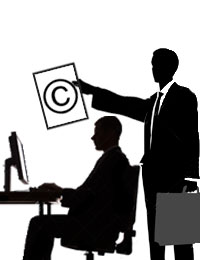
All's Fair in Love and Satire -- Or Is It? Fair Use Online
If you run a satire site, chances are you're going to offend someone eventually. Besides, that's the point, right? Satire sites exist to entertain an audience, of course, but that's a byproduct of the real purpose -- to expose and ridicule the hypocritical, nonsensical behavior of people in power. (We're ignoring "Area Man" social satire for this discussion, folks.)
So, you're going to offend someone. Maybe someone with money. And lawyers. And endless amounts of time to spend kicking the beejezus out of a satire editor like you, just to keep himself or herself busy between coffee breaks.
If it's going to happen, then you should be prepared. In our inaugural nuts-and-bolts feature for satire editors, we'll tell you about the different ways the excrement could hit the air-circulating apparatus; the legal concepts you need to understand; the resources available for your defense; and what you can do to fight back, instead of backing down.
And since we're talking about legal issues, we should add this disclaimer: Though this article is informative, it is not legal advice. You should consult an attorney if you find yourself in hot water. Think you can't afford an attorney? We'll change that assumption for you.
You know you're in trouble when...
You think you're having fun, getting a few laughs, not hurting anyone. Then it hits your inbox -- an e-mail from someone who didn't like the way you used their brand, product or name for your latest satirical effort. (Assuming you don't put your physical address or phone number on your site -- please tell me you don't do that, would you?)
Anyway, back to your inbox. This is the infamous cease and desist letter, or C&D. And when you get it, you might ask yourself, "Why me?" If you think you're the victim of a conspiracy to crack down on free speech, think again. The simple answer is, more lawyers are using the Internet than ever before.
"Search tools have made it easier to find things," notes Wendy Seltzer, project leader for Chilling Effects (www.chillingeffects.org) and staff attorney with the Electronic Frontier Foundation (www.eff.org). Every time a new tool becomes available, she sees an increase in the number of C&D letters received by various sites.
The C&D, Ms. Seltzer tells us, "doesn't have any legal status in most cases. It's more of an indication of how seriously [your satirical piece] is being taken." The Chilling Effects website, in fact, gets its name from the reaction that C&Ds are intended to give to those who receive them -- it "refers to the deterrent effect of legal threats or posturing, largely cease and desist letters independent of litigation, on lawful conduct," according to the website.
So, you've received a C&D. What's it likely to say? Well, C&Ds tend to have a few things in common:
1. Accusation. The writer of the C&D will claim that you have done something illegal. For example, let's say you Photoshopped a Reuters picture of Air Force One to look like a NASCAR vehicle -- plastered with corporate logos. (And no, the Green Party didn't pay us to come up with this example.)
2. Reasoning. The writer will tell you why s/he thinks what you've done is illegal. For example, Reuters may write to say that they own a copyright on the picture, and you can't use it without their permission. Or, Occidental Petroleum writes to tell you that their logo is trademarked, which gives them (and not you) the right to control how it's used.
3. Call to Action. The writer will demand that you stop doing that thing s/he claims is illegal (usually within a specific timeframe), and demand that you never do anything like that again. Pretty self-explanatory.
4. Your Accuser. You'll get the name and title of the person writing to you. This is a more subtle means of determining how serious the situation is. Generally speaking, it's more serious if it comes from an attorney than from, say, the marketing department.
That's the simple explanation. In reality, these letters will often use more nebulous terms and phrases -- ones that have very specific meanings in the world of lawyers and courts, some of which we'll talk about soon. But first, you may want to know...
Your Response
It's up to you, of course. The option with the lowest risk is to follow the instructions of the C&D letter, to the letter. Hopefully, what you've done isn't so egregious that they decide to come after you regardless of your compliance.
But...suppose you want to fight it. "It's hard to generalize for every case," Seltzer says, and that includes the first question you might ask yourself if you're going to fight it -- should I even respond to the C&D at all? "Individuals have to decide for themselves," Seltzer says, but if you do decide to respond to the C&D writer, she suggests you give only "the minimal response necessary of what you will do or won't do."
Other actions, such as sharing the C&D with you readers, can certainly draw publicity for your plight, shame the C&D writer into looking silly, and rally support for you. Seltzer points out that this is a "calculated risk," however, and could just make the C&D writer angrier.
But let's jump back a bit -- what do we mean by "minimal"? Well, a simple "no" is probably too minimal. Broadly speaking, you'll want to say that your work is satire and, as such, is protected under the "fair use" doctrine. If you really want to impress, you can add that the fair use doctrine is codified in 17 U.S.C. 107. Don't worry, we're about to explain what fair use is and how you can use it against your C&D oppressor in the next section.
Legal mumbo-jumbo
In simple, non-legally-binding language, "fair use" means that if you use parts of something that someone owns to make your satirical work, it's okay under certain circumstances. Who determines whether it's "okay"? A judge, if it ever gets that far. Said judge will check out your work, listen to the complaint against you, and makes the call.
That decision will hinge on different factors, since the bounds of fair use vary depending on whether you're dealing with copyrighted works or with trademarks.
Fair Use and Copyright
For copyright, Chilling Effects lists four criteria that courts generally evaluate when determining whether the use of copyrighted material in an infringement case is "fair use":
1. The purpose and character of the use -- why and how you've used the copyrighted material to create your satire. (Honorable motives are good here.)
2. The nature of the copyrighted work -- is it print, video? What's its reach? Does your satire reach a smaller or larger audience than the copyrighted work does? (It'd be nice for your traffic stats if it was a larger audience, but for this purpose, hope that it's smaller.)
3. The amount and substantiality of copying -- how much have you done, and how close is your satire to the real thing overall? (Yes, less is better.)
4. The market effect -- where's the money going? Are you taking any money away from the copyright holder? (Please, God, say no.)
Market effect, as you might guess, is the most important factor considered by a court. If the copyright holder's lawyers can prove that your work is taking money away from the copyright holder in general, or reducing the profitability of the copyrighted work in specific, you could be in a world of hurt.
Your best defense is to assert that your work does not compete in the market with theirs, because it is a satire or parody of the copyrighted work. This is more likely (but not guaranteed) to be considered "fair use" of the copyrighted work. Our parenthetical asides in the ordered list above indicate the answers that should bolster your defense of your satirical work under the fair use doctrine.
Fair Use and Trademarks
For trademarks, the court looks at two issues:
confusion and dilution. For satire editors, this primarily affects photoshopped satire and/or
merchandising, but the dilution issue applies to writing as well.
To confuse a consumer about a trademark is to make something that's so close to an existing trademark, the consumer will associate your item with the existing trademark. Chilling Effects offers an amusing example:
"If I were an unscrupulous manufacturer, I might attempt to capitalize on the fame of Star Trek by creating a line of 'Spock Activewear.' If consumers could reasonably believe that my activewear was produced or endorsed by the owners of the Spock trademark, then I would be liable for infringement."
Dilution is more of a touchy-feely issue. Trademarks, like brands, have a certain reputation and character in the consumer market. If you create something -- whether it's tangible (merchandise) or intangible (a satire article) -- that does damage to the trademark's reputation in the market, you could be accused of diluting the trademark.
Your defense on trademark issues comes not only from fair use, but from the First Amendment. But before we go further, you should know that trademark covers everything from company names to packaging. That includes logos, taglines, color schemes -- anything likely to be associated with the trademark or the company that holds it.
Chilling Effects describes the fair use defense succinctly: "A parody must convey two simultaneous -- and contradictory -- messages: that it is the original, but also that it is not the original and is instead a parody." Easy, right?
Another contributing factor is the answer to the following question -- how much of the trademark's attributes did you use to create your parody? Since trademark covers so many elements (from names to packaging and colors), it's impossible to determine where a court will draw the line between fair use and infringement.
So, unfortunately, the best we can suggest here is a rule of thumb -- the fewer attributes of the trademark you use, and the more apparent that it's a parody, the safer you should be.
Who ya gonna call?
Okay, so you've been contacted by a person, a company, or (gasp!) a government agency. Congratulations! A world of opportunity now awaits you. Don't worry about that gaping pit of fear in your stomach -- yet. As we've pointed out already, just because you've been contacted doesn't mean you'll be in court tomorrow.
To get an initial assessment of how serious the C&D letter is, you can submit it to Chilling Effects. Once received, it will be reviewed by law students who will analyze the content of the letter, and post it to the Chilling Effects C&D letter database, complete with annotations explaining the legal issues raised by the C&D, and a general assessment of what will have to be proven for any lawsuit to be successful against you.
Chilling Effects can give you a better idea about how serious the C&D letter is, but they can't represent you in court or give you legal advice. For that, you'll need to deal with a full-fledged attorney, directly. Luckily, resources are available for satire editors of moderate income. Chilling Effects will point you the direction of lawyers through links on its site. Here's two other options for you to pursue:
1. The American Civil Liberties Union. For your kind of problem, you won't be dealing with the national office -- you'll be able to act locally. Most states have at least one affiliate office, which handles First Amendment defenses.
Will they take your case? Well, we called not one, not two, but five affiliate offices (New York, New Hampshire, Massachusetts, Southern California, and the Dakotas) to get an answer to this question, and we got the same answer every time: "Write to us."
You'll have to compose a letter outlining exactly what's happened to you, and if you've received anything in writing (like a C&D letter), send a copy of that with your missive to your local ACLU office. Their "Legal Intake" folks (a staff attorney or attorneys) will examine your case and be in touch. Unless they're like the New Hampshire office, whose attorneys take off for the whole month of June. And they wonder why there's an endless supply of lawyer jokes to go around. Anyway, it can't hurt to try it.
2. The Electronic Frontier Foundation, which specifically champions freedom of speech online. They take cases "to protect the right to publish on the Internet without fear of trademark infringement lawsuits."
Will they take your case? You won't know until you contact them. They've defended people against the likes of the RIAA and the US Secret Service, and their clients have included school kids getting punished for satirizing their schools online. And the ACLU has a lot more irons in the fire, comparatively, so you've probably got a better shot at getting assistance from the EFF.
A famous example
In the satire world, one of the most high-profile fair use defenses in recent times was staged by the New York Civil Liberties Union, which acted on behalf of WhiteHouse.org, the website that parodies the official White House website. We'll walk you through the incident, using the handy-dandy guide that we've laid out in this article.
WhiteHouse.org had some fun at Second Lady Lynne Cheney's expense, and they received a C&D letter. Here's the breakdown:
1. Accusation: The letter accused WhiteHouse.org of using Mrs. Cheney's name and pictures for the purposes of trade (business), and that the site portrayed her in a false light.
2: Reasoning: Though not explicitly stated, the letter references previous court cases to unsubtly imply that there are negative consequences to doing these things.
3. Call to Action: The writer demanded a written confirmation that all photos and the fictitious bio of Mrs. Cheney would be removed from WhiteHouse.org.
4. The Accuser: The letter is signed by David Addington, legal counsel to Vice President Dick Cheney. Big time!
WhiteHouse.org reacted by posting the C&D on the site, added a highly sarcastic disclaimer to the beginning of the bio, and doctored the photos of Mrs. Cheney in an unflattering manner. Further, they posted a satire article, purported to be a statement from Vice President Cheney, about Cheney's demands in relation to the parody of his wife. It was the "shock and awe" response.
And rather than responding directly to Cheney's attorney, WhiteHouse.org contacted their local ACLU affiliate office, in New York. Considering the highly-placed accuser, the NYCLU was only too happy to fire right back. They sent their own letter in reply, and, amazingly, that seems to have been the end of it.
In a press release, NYCLU Executive Director Donna Lieberman said, "The right to parody political figures like Lynne Cheney lies at the heart of the First Amendment, and we will defend [WhiteHouse.org] against any effort to censor it by the Bush Administration. This is government intimidation pure and simple."
What Have We Learned, Charlie Brown?
We've learned a lot, Linus.
We've learned that getting a C&D letter is not only NOT the end of the world, it's a new beginning.
We've learned that having a basic idea of what constitutes fair use will improve your odds of being on the right side of the line in the sand when someone draws it.
And we learned that if you're going to make someone angry, make it someone as powerful as possible, so someone can get some good press out of defending you.
Resources
Electronic Frontier Foundation
ACLU Affiliate Listings Search
Fair Use, from the US Copyright Office
Fair Use Doctrine -- Text of the Law from the Legal Information Institute
Famous Example:
C&D letter from Dick Cheney's lawyer to WhiteHouse.org
WhiteHouse.org's Lynne Cheney bio page, with added disclaimer
WhiteHouse.org's take on the Cheney letter
Chilling Effects' Breakdown of the C&D
New York Civil Liberties Union Press Release on Their Response
BuzzFlash Interview with John Wooden of WhiteHouse.org
Salon.com Interview with John Wooden of WhiteHouse.org




